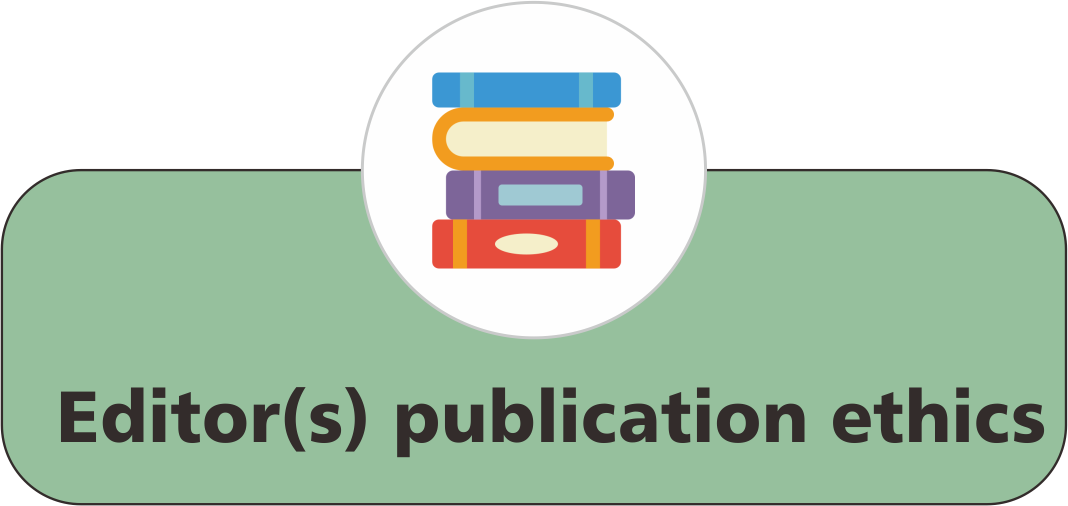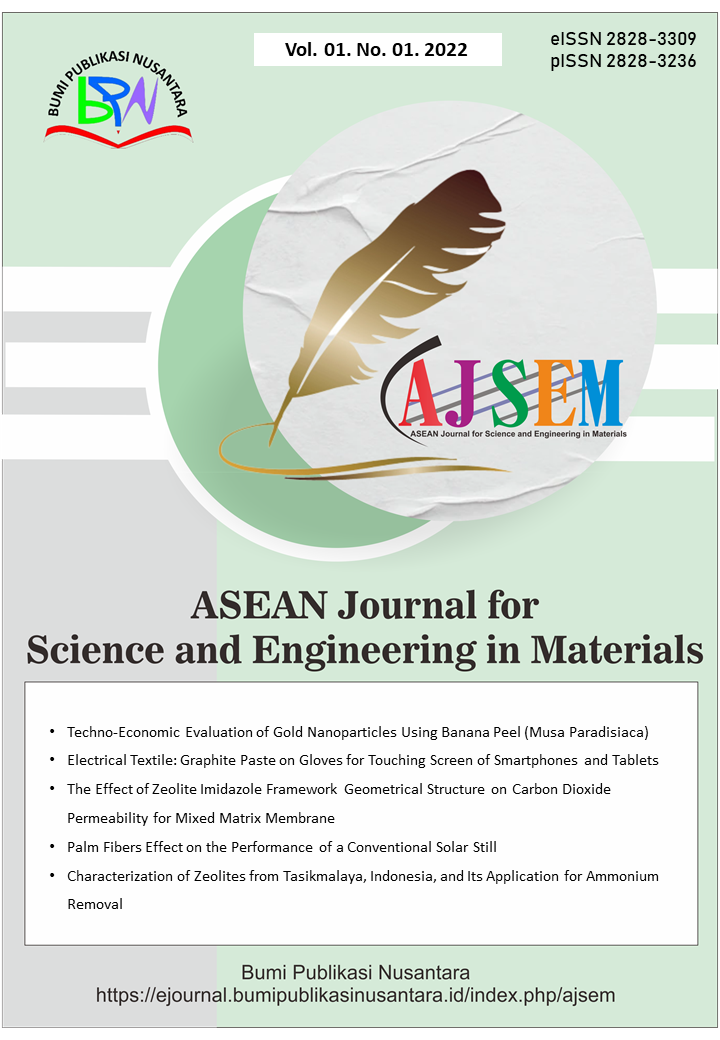Definition and Role of Sustainable Materials in Reaching Global Sustainable Development Goals (SDGs) Completed with Bibliometric Analysis
 ), Asep Bayu Dani Nandiyanto(2), Obie Farobie(3), Teguh Kurniawan(4), M. Roil Bilad(5),
), Asep Bayu Dani Nandiyanto(2), Obie Farobie(3), Teguh Kurniawan(4), M. Roil Bilad(5),
(1) Universitas Pendidikan Indonesia
(2) Universitas Pendidikan Indonesia
(3) IPB University
(4) Universitas Sultan Ageng Tirtayasa
(5) University Brunei Darussalam
 Corresponding Author
Corresponding Author
Abstract
Keywords
References
Acharjee, S. A., Gogoi, B., Bharali, P., Sorhie, V., and Alemtoshi, B. W. (2024). Recent trends in the development of Polyhydroxyalkanoates (PHAs) based biocomposites by blending with different bio-based polymers. Journal of Polymer Research, 31(4), 98.
Ahmed, M., and Mohammed, K. I. (2024). New frontiers in solid-state and material science for manufacturing and technological growth. Journal of Basics and Applied Sciences Research, 2(4), 38-43.
Aït-Kaddour, A., Hassoun, A., Tarchi, I., Loudiyi, M., Boukria, O., Cahyana, Y., ... and Khwaldia, K. (2024). Transforming plant-based waste and by-products into valuable products using various “Food Industry 4.0” enabling technologies: A literature review. Science of the Total Environment, 176872.
Al Husaeni, D.F., and Nandiyanto, A.B.D. (2022). Bibliometric using VOSviewer with publish or perish (using google scholar data): From step-by-step processing for users to the practical examples in the analysis of digital learning articles in pre and post covid-19 pandemic. ASEAN Journal of Science and Engineering, 2(1), 19-46.
Al Husaeni, D.N., and Al Husaeni, D.F. (2022). How to calculate bibliometric using VOSviewer with Publish or Perish (using Scopus data): Science education keywords. Indonesian Journal of Educational Research and Technology, 2(3), 247-274.
Alkhalaf, M. I., Hussein, R. H., and Hamza, A. (2020). Green synthesis of silver nanoparticles by Nigella sativa extract alleviates diabetic neuropathy through anti-inflammatory and antioxidant effects. Saudi Journal of Biological Sciences, 27(9), 2410-2419.
Amponsah, O., Nopuo, P. S. A., Manga, F. A., Catli, N. B., and Labus, K. (2025). Future-Oriented Biomaterials Based on Natural Polymer Resources: Characteristics, Application Innovations, and Development Trends. International Journal of Molecular Sciences, 26(12), 5518.
Anastas, P. T., and Warner, J. C. (1998). Principles of green chemistry. Green chemistry: Theory and practice, 29, 14821-14842.
Apriliani, A., Waahyudin, C., Ramdani, F.T., Martin, A.Y., Syahrudin, D., Hernawan, D., and Salbiah, E. (2026). Techno-economic analysis of sawdust-based trash cans and their contribution to indonesia’s green tourism policy and the sustainable development goals (SDGs). ASEAN Journal for Science and Engineering in Materials, 5(1), 17-36.
Arokiyaraj, S., Arasu, M. V., Vincent, S., Prakash, N. U., Choi, S. H., Oh, Y. K., and Kim, K. H. (2014). Rapid green synthesis of silver nanoparticles from Chrysanthemum indicum L and its antibacterial and cytotoxic effects: an in vitro study. International Journal of Nanomedicine, 9, 379-388.
Arunachalam, K. D., Annamalai, S. K., and Hari, S. (2013). One-step green synthesis and characterization of leaf extract-mediated biocompatible silver and gold nanoparticles from Memecylon umbellatum. International Journal of Nanomedicine, 1307-1315.
Awalussillmi, I., Febriyana, K.R., Padilah, N., and Saadah, N.A. (2023). Efforts to improve sustainable development goals (SDGs) through education on diversification of food using infographic: Animal and vegetable protein. ASEAN Journal of Agricultural and Food Engineering, 2(2), 113-120.
Banigo, A. T., Iwuji, S. C., and Iheaturu, N. C. (2019). Application of biomaterials in tissue engineering: a review. Journal of Chemical and Pharmaceutical Research, 11(4), 1-16.
Barai, A. C., Paul, K., Dey, A., Manna, S., Roy, S., Bag, B. G., and Mukhopadhyay, C. (2018). Green synthesis of Nerium oleander-conjugated gold nanoparticles and study of its in vitro anticancer activity on MCF-7 cell lines and catalytic activity. Nano Convergence, 5, 1-9.
Baranwal, J., Barse, B., Fais, A., Delogu, G. L., and Kumar, A. (2022). Biopolymer: A sustainable material for food and medical applications. Polymers, 14(5), 983.
Basnur, J., Putra, M.F.F., Jayusman, S.V.A., and Zulhilmi, Z. (2024). Sustainable packaging: Bioplastics as a low-carbon future step for the sustainable development goals (SDGs). ASEAN Journal for Science and Engineering in Materials, 3(1), 51-58.
Cai, W., Weng, X., and Chen, Z. (2019). Highly efficient removal of antibiotic rifampicin from aqueous solution using green synthesis of recyclable nano-Fe3O4. Environmental Pollution, 247, 839-846.
Cesário, M. T., Raposo, R. S., de Almeida, M. C. M., van Keulen, F., Ferreira, B. S., and da Fonseca, M. M. R. (2014). Enhanced bioproduction of poly-3-hydroxybutyrate from wheat straw lignocellulosic hydrolysates. New Biotechnology, 31(1), 104-113.
Chaikittisilp, W., Yamauchi, Y., and Ariga, K. (2022). Material evolution with nanotechnology, nanoarchitectonics, and materials informatics: what will be the next paradigm shift in nanoporous materials?. Advanced Materials, 34(7), 2107212.
Chen, L., Yang, M., Chen, Z., Xie, Z., Huang, L., Osman, A. I., ... and Yap, P. S. (2024). Conversion of waste into sustainable construction materials: A review of recent developments and prospects. Materials Today Sustainability, 100930.
Chen, L., Yang, M., Chen, Z., Xie, Z., Huang, L., Osman, A. I., ... and Yap, P. S. (2024). Conversion of waste into sustainable construction materials: A review of recent developments and prospects. Materials Today Sustainability, 100930.
Crespilho, F. N., Costa, C. M., and Lanceros‐Méndez, S. (2025). Sustainable Battery Biomaterials. ChemElectroChem, 12(3), e202400530.
Darder, M., Aranda, P., and Ruiz‐Hitzky, E. (2007). Bionanocomposites: a new concept of ecological, bioinspired, and functional hybrid materials. Advanced Materials, 19(10), 1309-1319.
Djirong, A., Jayadi, K., Abduh, A., Mutolib, A., Mustofa, R.F., and Rahmat, A. (2024). Assessment of student awareness and application of eco-friendly curriculum and technologies in Indonesian higher education for supporting sustainable development goals (SDGs): A case study on environmental challenges. Indonesian Journal of Science and Technology, 9(3), 657-678.
Dobrzański, L. A., Pawlyta, M., and Hudecki, A. (2011). Conceptual study on a new generation of the high-innovative advanced porous and composite nanostructural functional materials with nanofibers. Journal of Achievements in Materials and Manufacturing Engineering, 49(2), 550-565.
Elfakhri, F., Alkahtani, R., Li, C., and Khaliq, J. (2022). Influence of filler characteristics on the performance of dental composites: A comprehensive review. Ceramics International, 48(19), 27280-27294.
Espinosa, S. A., Bala, A., and Fullana-i-Palmer, P. (2022). Life cycle assessment as a tool for evaluating chemical processes at industrial scale: a review. Green Chemistry, 24(20), 7751-7762.
Fei, W., Opoku, A., Agyekum, K., Oppon, J. A., Ahmed, V., Chen, C., and Lok, K. L. (2021). The critical role of the construction industry in achieving the sustainable development goals (SDGs): Delivering projects for the common good. Sustainability, 13(16), 9112.
Fenton, O. S., Olafson, K. N., Pillai, P. S., Mitchell, M. J., and Langer, R. (2018). Advances in biomaterials for drug delivery. Advanced Materials, 30(29), 1705328.
García-Quintero, A., and Palencia, M. (2021). A critical analysis of environmental sustainability metrics applied to green synthesis of nanomaterials and the assessment of environmental risks associated with the nanotechnology. Science of the Total Environment, 793, 148524.
Gemil, K.W., Na’ila, D.S., Ardila, N.Z., and Sarahah, Z.U. (2024). The relationship of vocational education skills in agribusiness processing agricultural products in achieving sustainable development goals (SDGs). ASEAN Journal of Science and Engineering Education, 4(2), 181-192.
Ghosh, S., Patil, S., Ahire, M., Kitture, R., Gurav, D. D., Jabgunde, A. M., and Chopade, B. A. (2012). Gnidia glauca flower extract mediated synthesis of gold nanoparticles and evaluation of its chemocatalytic potential. Journal of Nanobiotechnology, 10, 1-9.
Glovatskii, O., Kalimbetov, B., Ergashev, R., Kholbutaev, B., Pardaev, M., Ergasheva, G., Nasirova, N., and Khimmataliev, D.O. (2025). Modernization of Submersible Pump Designs for Sustainable Irrigation: A Bibliometric and Experimental Contribution to Sustainable Development Goals (SDGs). Indonesian Journal of Science and Technology, 10(3), 427-438.
Guerra, F. D., Attia, M. F., Whitehead, D. C., and Alexis, F. (2018). Nanotechnology for environmental remediation: materials and applications. Molecules, 23(7), 1760.
Guinée, J. B., de Koning, A., and Heijungs, R. (2022). Life cycle assessment‐based Absolute Environmental Sustainability Assessment is also relative. Journal of Industrial Ecology, 26(3), 673-682.
Gupta, A. K., and Gupta, M. (2005). Synthesis and surface engineering of iron oxide nanoparticles for biomedical applications. biomaterials, 26(18), 3995-4021.
Gupta, D., Boora, A., Thakur, A., and Gupta, T. K. (2023). Green and sustainable synthesis of nanomaterials: recent advancements and limitations. Environmental Research, 231, 116316.
Haq, M.R.I., Nurhaliza, D.V., Rahmat, L.N., and Ruchiat, R.N.A. (2024). The influence of environmentally friendly packaging on consumer interest in implementing zero waste in the food industry to meet sustainable development goals (SDGs) needs. ASEAN Journal of Economic and Economic Education, 3(2), 111-116.
Harish, V., Ansari, M. M., Tewari, D., Gaur, M., Yadav, A. B., García-Betancourt, M. L., and Barhoum, A. (2022). Nanoparticle and nanostructure synthesis and controlled growth methods. Nanomaterials, 12(18), 3226.
Henny, H., Budi, A.H.S., Andriyansyah, M., Ar Rozzak, M.R., Baru, M.M., and Masek, A. (2025). Hazard identification, risk assessment, and determining control (HIRADC) for workplace safety in manufacturing industry: A risk-control framework complete with bibliometric literature review analysis to support sustainable development goals (SDGs). ASEAN Journal for Science and Engineering in Materials, 4(2), 267-284.
Huang, H., Feng, W., and Chen, Y. (2021). Two-dimensional biomaterials: material science, biological effect and biomedical engineering applications. Chemical Society Reviews, 50(20), 11381-11485.
Huang, L. J., Geng, L., and Peng, H. X. (2015). Microstructurally inhomogeneous composites: is a homogeneous reinforcement distribution optimal?. Progress in Materials Science, 71, 93-168.
Hussain, S., Akhter, R., and Maktedar, S. S. (2024). Advancements in sustainable food packaging: from eco-friendly materials to innovative technologies. Sustainable Food Technology, 2(5), 1297-1364.
Irfan, M., Munir, H., and Ismail, H. (2021). Moringa oleifera gum based silver and zinc oxide nanoparticles: green synthesis, characterization and their antibacterial potential against MRSA. Biomaterials Research, 25(1), 17.
Islam, S., Weerasinghe, H., Prado, D. M., Gonzaga, A. N., and Burda, C. (2025). Diversifying the Materials and Technologies for the Future of Energy Storage. Energy and Fuels, 39(18), 8369-8390.
Jamkhande, P. G., Ghule, N. W., Bamer, A. H., and Kalaskar, M. G. (2019). Metal nanoparticles synthesis: An overview on methods of preparation, advantages and disadvantages, and applications. Journal of Drug Delivery Science and Technology, 53, 101174.
Jayachandran, A., Aswathy, T. R., and Nair, A. S. (2021). Green synthesis and characterization of zinc oxide nanoparticles using Cayratia pedata leaf extract. Biochemistry and Biophysics Reports, 26, 100995.
Jin, H., Xu, J., Liu, H., Shen, H., Yu, H., Jaroniec, M., and Qiao, S. Z. (2023). Emerging materials and technologies for electrocatalytic seawater splitting. Science Advances, 9(42), eadi7755.
Kaliraj, L., Ahn, J. C., Rupa, E. J., Abid, S., Lu, J., and Yang, D. C. (2019). Synthesis of panos extract mediated ZnO nano-flowers as photocatalyst for industrial dye degradation by UV illumination. Journal of Photochemistry and Photobiology B: Biology, 199, 111588.
Kalt, G., Thunshirn, P., Wiedenhofer, D., Krausmann, F., Haas, W., and Haberl, H. (2021). Material stocks in global electricity infrastructures–An empirical analysis of the power sector's stock-flow-service nexus. Resources, Conservation and Recycling, 173, 105723.
Kambale, E. K., Nkanga, C. I., Mutonkole, B. P. I., Bapolisi, A. M., Tassa, D. O., Liesse, J. M. I., and Memvanga, P. B. (2020). Green synthesis of antimicrobial silver nanoparticles using aqueous leaf extracts from three Congolese plant species (Brillantaisia patula, Crossopteryx febrifuga and Senna siamea). Heliyon, 6(8), e04493.
Kanan, S., Moyet, M. A., Arthur, R. B., and Patterson, H. H. (2020). Recent advances on TiO2-based photocatalysts toward the degradation of pesticides and major organic pollutants from water bodies. Catalysis Reviews, 62(1), 1-65.
Keisyafa, A., Sunarya, D.N., Aghniya, S.M., and Maula, S.P. (2024). Analysis of student’s awareness of sustainable diet in reducing carbon footprint to support sustainable development goals (SDGs) 2030. ASEAN Journal of Agricultural and Food Engineering, 3(1), 67-74.
Kerans, G., Sanjaya, Y., Liliasari, L., Pamungkas, J., and Ate, G., Y. (2024). Effect of substrate and water on cultivation of Sumba seaworm (nyale) and experimental practicum design for improving critical and creative thinking skills of prospective science teacher in biology and supporting sustainable development goals (SDGs). ASEAN Journal of Science and Engineering, 4(3), 383-404.
Khalilov, R. (2023). A comprehensive review of advanced nano-biomaterials in regenerative medicine and drug delivery. Advances in Biology and Earth Sciences, 8(1).
Khan, S. A., Shahid, S., and Lee, C. S. (2020). Green synthesis of gold and silver nanoparticles using leaf extract of Clerodendrum inerme; characterization, antimicrobial, and antioxidant activities. Biomolecules, 10(6), 835.
Khan, S. A., Shahid, S., Hanif, S., Almoallim, H. S., Alharbi, S. A., and Sellami, H. (2021). Green synthesis of chromium oxide nanoparticles for antibacterial, antioxidant anticancer, and biocompatibility activities. International Journal of Molecular Sciences, 22(2), 502.
Khani, R., Roostaei, B., Bagherzade, G., and Moudi, M. (2018). Green synthesis of copper nanoparticles by fruit extract of Ziziphus spina-christi (L.) Willd.: Application for adsorption of triphenylmethane dye and antibacterial assay. Journal of Molecular Liquids, 255, 541-549.
Komnitsas, K. A. (2011). Potential of geopolymer technology towards green buildings and sustainable cities. Procedia Engineering, 21, 1023-1032.
Krauklis, A. E., Karl, C. W., Gagani, A. I., and Jørgensen, J. K. (2021). Composite material recycling technology—state-of-the-art and sustainable development for the 2020s. Journal of Composites Science, 5(1), 28.
Krishnan, A., Al-Obaidi, A.S.M., and Hao, L.C. (2024). Towards sustainable wind energy: A systematic review of airfoil and blade technologies over the past 25 years for supporting sustainable development goals (SDGs). Indonesian Journal of Science and Technology, 9(3), 623-656.
Kumar, A., Kuang, Y., Liang, Z., and Sun, X. (2020). Microwave chemistry, recent advancements, and eco-friendly microwave-assisted synthesis of nanoarchitectures and their applications: a review. Materials Today Nano, 11, 100076.
Lemons, J. E., and Lucas, L. C. (1986). Properties of biomaterials. The Journal of arthroplasty, 1(2), 143-147.
Lenzen, M., Geschke, A., West, J., Fry, J., Malik, A., Giljum, S., ... and Schandl, H. (2022). Implementing the material footprint to measure progress towards Sustainable Development Goals 8 and 12. Nature Sustainability, 5(2), 157-166.
Li, X., Qin, D., Hu, Y., Ahmad, W., Ahmad, A., Aslam, F., and Joyklad, P. (2022). A systematic review of waste materials in cement-based composites for construction applications. Journal of Building Engineering, 45, 103447.
Li, Y., Shen, J., Lin, H., and Li, Y. (2023). Optimization design for alkali-activated slag-fly ash geopolymer concrete based on artificial intelligence considering compressive strength, cost, and carbon emission. Journal of Building Engineering, 75, 106929.
Lombardo, D., Calandra, P., Pasqua, L., and Magazù, S. (2020). Self-assembly of organic nanomaterials and biomaterials: The bottom-up approach for functional nanostructures formation and advanced applications. Materials, 13(5), 1048.
Madan, H. R., Sharma, S. C., Suresh, D., Vidya, Y. S., Nagabhushana, H., Rajanaik, H., and Maiya, P. S. (2016). Facile green fabrication of nanostructure ZnO plates, bullets, flower, prismatic tip, closed pine cone: their antibacterial, antioxidant, photoluminescent and photocatalytic properties. Spectrochimica Acta Part A: Molecular and Biomolecular Spectroscopy, 152, 404-416.
Mahmood, S., Sun, H., Iqbal, A., Alhussan, A. A., and El-kenawy, E. S. M. (2024). Green finance, sustainable infrastructure, and green technology innovation: pathways to achieving sustainable development goals in the belt and road initiative. Environmental Research Communications, 6(10), 105036.
Makinde, S.O., Ajani, Y.A., and Abdulrahman, M.R. (2024). Smart learning as transformative impact of technology: A paradigm for accomplishing sustainable development goals (SDGs) in education. Indonesian Journal of Educational Research and Technology, 4(3), 213-224.
Martins, R. (2021). Materials as activator of future global science and technology challenges. Progress in Natural Science: Materials International, 31(6), 785-791.
Maryanti, R., Rahayu, N., Muktiarni, M., Al Husaeni, D. F., Hufad, A., Sunardi, S., & Nandiyanto, A. B. D. (2022). Sustainable development goals (SDGs) in science education: Definition, literature review, and bibliometric analysis. Journal of Engineering Science and Technology, 17, 161-181.
Mathevet, R., Bousquet, F., and Raymond, C. M. (2018). The concept of stewardship in sustainability science and conservation biology. Biological conservation, 217, 363-370.
Matlin, S. A., Cornell, S. E., Kümmerer, K., Mahaffy, P. G., and Mehta, G. (2025). Inventing a secure future: material stewardship as chemistry's mission for sustainability. RSC Sustainability, 3(2), 804-821.
Matlin, S. A., Mehta, G., Cornell, S. E., Krief, A., and Hopf, H. (2023). Chemistry and pathways to net zero for sustainability. RSC Sustainability, 1(7), 1704-1721.
Maulana, I., Asran, M.A., and Ash-Habi, R.M. (2023). Implementation of sustainable development goals (SDGs) no. 12: Responsible production and consumption by optimizing lemon commodities and community empowerment to reduce household waste. ASEAN Journal of Community Service and Education, 2(2), 141-146.
Mazitova, A. K., Zaripov, I. I., Aminova, G. K., Ovod, M. V., and Suntsova, N. L. (2022). Fillers for polymer composite materials. Nanotekhnologii v Stroitel'stve, 14(4), 294-299.
Merzouki, M., Khibech, O., Fraj, E., Bouammali, H., Bourhou, C., Hammouti, B., Bouammali, B., and Challioui, A. (2025). Computational engineering of malonate and tetrazole derivatives targeting SARS-CoV-2 main protease: Pharmacokinetics, docking, and molecular dynamics insights to support the sustainable development goals (SDGs), with a bibliometric analysis. Indonesian Journal of Science and Technology, 10(2), 399-418.
Mishra, B., Mohanta, Y. K., Reddy, C. N., Reddy, S. D. M., Mandal, S. K., Yadavalli, R., and Sarma, H. (2023). Valorization of agro-industrial biowaste to biomaterials: An innovative circular bioeconomy approach. Circular Economy, 2(3), 100050.
Mohanty, A. K., Vivekanandhan, S., Pin, J. M., and Misra, M. (2018). Composites from renewable and sustainable resources: Challenges and innovations. Science, 362(6414), 536-542.
Mondal, P., Anweshan, A., and Purkait, M. K. (2020). Green synthesis and environmental application of iron-based nanomaterials and nanocomposite: A review. Chemosphere, 259, 127509.
Moradeeya, P. G., Sharma, A., Kumar, M. A., and Basha, S. (2022). Titanium dioxide based nanocomposites–current trends and emerging strategies for the photocatalytic degradation of ruinous environmental pollutants. Environmental Research, 204, 112384.
Namoussa, T.Y., Boucerredj,L., Khechekhouche, A., Kemerchou, I., Zair, N., Jahangiri, M., Miloudi, A., and Siqueira, A. (2025). Innovative nanofluid encapsulation in solar stills: Boosting water yield and efficiency under extreme climate supporting sustainable development goals (SDGs). Indonesian Journal of Science and Technology, 10(3), 419-426.
Nasrollahzadeh, M., Sajjadi, M., Iravani, S., and Varma, R. S. (2021). Green-synthesized nanocatalysts and nanomaterials for water treatment: Current challenges and future perspectives. Journal of hazardous materials, 401, 123401.
Nilimaa, J. (2023). Smart materials and technologies for sustainable concrete construction. Developments in the Built Environment, 15, 100177.
Nurnabila, A.T., Basnur, J., Rismayani, R., Ramadhani, S., and Zulhilmi, Z. (2023). Analysis of the application of mediterranean diet patterns on sustainability to support the achievement of sustainable development goals (SDGs): Zero hunger, good health and well beings, responsible consumption, and production. ASEAN Journal of Agricultural and Food Engineering, 2(2), 105-112.
Nurramadhani, A., Riandi, R., Permanasari, A., and Suwarma, I.R. (2024). Low-carbon food consumption for solving climate change mitigation: Literature review with bibliometric and simple calculation application for cultivating sustainability consciousness in facing sustainable development goals (SDGs). Indonesian Journal of Science and Technology, 9(2), 261-286.
Obruca, S., Benesova, P., Marsalek, L., and Marova, I. (2015). Use of lignocellulosic materials for PHA production. Chemical and Biochemical Engineering Quarterly, 29(2), 135-144.
Oves, M., Rauf, M. A., Aslam, M., Qari, H. A., Sonbol, H., Ahmad, I., and Saeed, M. (2022). Green synthesis of silver nanoparticles by Conocarpus Lancifolius plant extract and their antimicrobial and anticancer activities. Saudi Journal of Biological Sciences, 29(1), 460-471.
Pallas, G., Vijver, M. G., Peijnenburg, W. J., and Guinée, J. (2020). Ex ante life cycle assessment of GaAs/Si nanowire–based tandem solar cells: A benchmark for industrialization. The International Journal of Life Cycle Assessment, 25, 1767-1782.
Patel, A., and Taufik, M. (2022). Advances in nanocomposite material for fused filament fabrication. Polymer-Plastics Technology and Materials, 61(15), 1617-1661.
Patra, J. K., and Baek, K. H. (2015). Novel green synthesis of gold nanoparticles using Citrullus lanatus rind and investigation of proteasome inhibitory activity, antibacterial, and antioxidant potential. International Journal of Nanomedicine, 7253-7264.
Peng, S., Jin, G., Li, L., Li, K., Srinivasan, M., Ramakrishna, S., and Chen, J. (2016). Multi-functional electrospun nanofibres for advances in tissue regeneration, energy conversion and storage, and water treatment. Chemical Society Reviews, 45(5), 1225-1241.
Perez, R. A., Won, J. E., Knowles, J. C., and Kim, H. W. (2013). Naturally and synthetic smart composite biomaterials for tissue regeneration. Advanced Drug Delivery Reviews, 65(4), 471-496.
Pillai, C. K. S. (2010). Challenges for natural monomers and polymers: novel design strategies and engineering to develop advanced polymers. Designed Monomers and Polymers, 13(2), 87-121.
Priyadarshini, B., and Vijayalakshmi, U. (2018). Development of cerium and silicon co-doped hydroxyapatite nanopowder and its in vitro biological studies for bone regeneration applications. Advanced Powder Technology, 29(11), 2792-2803.
Priyadarshini, B., Anjaneyulu, U., and Vijayalakshmi, U. (2017). Preparation and characterization of sol-gel derived Ce 4+ doped hydroxyapatite and its in vitro biological evaluations for orthopedic applications. Materials and Design, 119, 446-455.
Priyadarshini, B., Stango, A. X., Balasubramanian, M., and Vijayalakshmi, U. (2023). In situ fabrication of cerium-incorporated hydroxyapatite/magnetite nanocomposite coatings with bone regeneration and osteosarcoma potential. Nanoscale Advances, 5(18), 5054-5076.
Qamar, H., Rehman, S., Chauhan, D. K., Tiwari, A. K., and Upmanyu, V. (2020). Green synthesis, characterization and antimicrobial activity of copper oxide nanomaterial derived from Momordica charantia. International Journal of Nanomedicine, 2541-2553.
Raabe, D. (2023). The materials science behind sustainable metals and alloys. Chemical reviews, 123(5), 2436-2608.
Raak, N., Symmank, C., Zahn, S., Aschemann-Witzel, J., and Rohm, H. (2017). Processing-and product-related causes for food waste and implications for the food supply chain. Waste Management, 61, 461-472.
Ragadhita, R., Fiandini, M., Al Husaeni, D.N., and Nandiyanto, A.B.D. (2026). Sustainable development goals (SDGs) in engineering education: Definitions, research trends, bibliometric insights, and strategic approaches. Indonesian Journal of Science and Technology, 11(1), 1-26.
Rahmah, F.A., Nurlaela, N., Anugrah, R., and Putri, Y.A.R. (2024). Safe food treatment technology: The key to realizing the sustainable development goals (SDGs) zero hunger and optimal health. ASEAN Journal of Agricultural and Food Engineering, 3(1), 57-66.
Rahmat, A., Zahrani, A., Hidayat, H., Arum, F., Respati, S.A., Susanti, W.D., Hariadi, H., Mutolib, A. (2025). Characteristics of jengkol peel (Pithecellobium jiringa) biochar produced at various pyrolysis temperatures for enhanced agricultural waste management and supporting sustainable development goals (SDGs). ASEAN Journal of Science and Engineering, 5(1), 145-172.
Rajak, D. K., Pagar, D. D., Menezes, P. L., and Linul, E. (2019). Fiber-reinforced polymer composites: Manufacturing, properties, and applications. Polymers, 11(10), 1667.
Ramakrishnan, T., Mohan Gift, M. D., Chitradevi, S., Jegan, R., Hency Jose, P. S., Nagaraja, H. N., and Hailegiorgis, S. M. (2022). Study of numerous resins used in polymer matrix composite materials. Advances in Materials Science and Engineering, 2022(1), 1088926.
Ravindran, R., and Jaiswal, A. K. (2016). Exploitation of food industry waste for high-value products. Trends in Biotechnology, 34(1), 58-69.
Rebouillat, S., and Pla, F. (2016). Recent strategies for the development of biosourced-monomers, oligomers and polymers-based materials: A review with an innovation and a bigger data focus. Journal of Biomaterials and Nanobiotechnology, 7(04), 167.
Reuter, M. A., van Schaik, A., Gutzmer, J., Bartie, N., and Abadías-Llamas, A. (2019). Challenges of the circular economy: a material, metallurgical, and product design perspective. Annual Review of Materials Research, 49(1), 253-274.
Rochman, S., Rustaman, N., Ramalis, T.R., Amri, K., Zukmadini, A.Y., Ismail, I., and Putra, A.H. (2024). How bibliometric analysis using VOSviewer based on artificial intelligence data (using ResearchRabbit Data): Explore research trends in hydrology content. ASEAN Journal of Science and Engineering, 4(2), 251-294.
Safari, J., and Javadian, L. (2015). Ultrasound assisted the green synthesis of 2-amino-4H-chromene derivatives catalyzed by Fe3O4-functionalized nanoparticles with chitosan as a novel and reusable magnetic catalyst. Ultrasonics Sonochemistry, 22, 341-348.
Sandanayake, M., Gunasekara, C., Law, D., Zhang, G., and Setunge, S. (2018). Greenhouse gas emissions of different fly ash based geopolymer concretes in building construction. Journal of cleaner production, 204, 399-408.
Santhosh, C., Velmurugan, V., Jacob, G., Jeong, S. K., Grace, A. N., and Bhatnagar, A. (2016). Role of nanomaterials in water treatment applications: a review. Chemical Engineering Journal, 306, 1116-1137.
Sesrita, A., Adri, H.T., Suherman, I., Rasmitadila, R., and Fanani, M.Z. (2025). Production of wet organic waste ecoenzymes as an alternative solution for environmental conservation supporting sustainable development goals (SDGs): A techno-economic and bibliometric analysis. ASEAN Journal for Science and Engineering in Materials, 4(2), 245-266.
Sharma, A. K., Bhandari, R., Aherwar, A., and Rimašauskienė, R. (2020). Matrix materials used in composites: A comprehensive study. Materials Today: Proceedings, 21, 1559-1562.
Soegoto, H.S., Pohan, M.A.R., Luckyardi, S., Supatmi, S., Amasawa, E., Phithakkitnukoon, S., and Hasibuan, Z.A. (2025). Contributing factors to greenhouse gas emissions in agriculture for supporting sustainable development goals (SDGs): Insights from a systematic literature review completed by computational bibliometric analysis. ASEAN Journal of Science and Engineering, 5(2), 199-230
Stamatakis, G. (2010). Energy and geo-environmental applications for olive mill wastes. a review. Hellenic Journal of Geosciences, 45(1), 269-282.
Syahrudin, D., Roestamy, M., Fauziah, R.S.P., Rahmawati, R., Pratidina, G., Purnamasari, I., Muhtar, S., and Salbiah, E. (2026). Techno-economic analysis of production ecobrick from plastic waste to support sustainable development goals (SDGs). ASEAN Journal for Science and Engineering in Materials, 5(1), 9-16.
Thamaraiselvi, T., and Rajeswari, S. (2004). Biological evaluation of bioceramic materials-a review. Carbon, 24(31), 172.
Thoniyot, P., Tan, M. J., Karim, A. A., Young, D. J., and Loh, X. J. (2015). Nanoparticle–hydrogel composites: Concept, design, and applications of these promising, multi‐functional materials. Advanced Science, 2(1-2), 1400010.
Thovhogi, N., Park, E., Manikandan, E., Maaza, M., and Gurib-Fakim, A. (2016). Physical properties of CdO nanoparticles synthesized by green chemistry via Hibiscus Sabdariffa flower extract. Journal of Alloys and Compounds, 655, 314-320.
Tiwari, A. (2023). Advancement of materials to sustainable and green world. Sustainable Development, 2018, 2028.
Van Thuan, D., Ngo, H. L., Thi, H. P., and Chu, T. T. H. (2023). Photodegradation of hazardous organic pollutants using titanium oxides-based photocatalytic: A review. Environmental Research, 229, 116000.
Villaseñor, M. J., and Ríos, Á. (2018). Nanomaterials for water cleaning and desalination, energy production, disinfection, agriculture and green chemistry. Environmental chemistry letters, 16, 11-34.
Waardhani, A.W., Noviyanti, A.R., Kusrini, E., Nugrahaningtyas, K.D., Prasetyo, A.B., Usman, A., Irwansyah, F.S., and Juliandri, J. (2025). A study on sustainable eggshell-derived hydroxyapatite/CMC membranes: Enhancing flexibility and thermal stability for sustainable development goals (SDGs). Indonesian Journal of Science and Technology, 10(2), 191-206.
Whalen, J. M., Matlin, S. A., Holme, T. A., Stewart, J. J., and Mahaffy, P. G. (2022). A systems approach to chemistry is required to achieve sustainable transformation of matter: The case of ammonia and reactive nitrogen. ACS Sustainable Chemistry and Engineering, 10(39), 12933-12947.
Wu, W., He, Q., and Jiang, C. (2008). Magnetic iron oxide nanoparticles: synthesis and surface functionalization strategies. Nanoscale research letters, 3, 397-415.
Wu, W., Xiao, X. H., Ren, F., Zhang, S. F., and Jiang, C. Z. (2012). A comparative study of the magnetic behavior of single and tubular clustered magnetite nanoparticles. Journal of Low Temperature Physics, 168, 306-313.
Yadav, N., and Singh, S. (2021). Polyoxometalate-mediated vacancy-engineered cerium oxide nanoparticles exhibiting controlled biological enzyme-mimicking activities. Inorganic Chemistry, 60(10), 7475-7489.
Yang, X., Lee, S. J., Yoo, H. Y., Choi, H. S., Park, C., and Kim, S. W. (2014). Biorefinery of instant noodle waste to biofuels. Bioresource Technology, 159, 17-23.
Yeo, J. C. C., Muiruri, J. K., Fei, X., Wang, T., Zhang, X., Xiao, Y., ... and Li, Z. (2024). Innovative biomaterials for food packaging: Unlocking the potential of polyhydroxyalkanoate (PHA) biopolymers. Biomaterials Advances, 163, 213929.
Yusefi, M., Shameli, K., Su Yee, O., Teow, S. Y., Hedayatnasab, Z., Jahangirian, H., and Kuča, K. (2021). Green synthesis of Fe3O4 nanoparticles stabilized by a Garcinia mangostana fruit peel extract for hyperthermia and anticancer activities. International Journal of Nanomedicine, 2515-2532.
Yustiarini, D., Soemardi, B.W., and Pribadi, K.S. (2025). Integrating multi-stakeholder governance, engineering approaches, and bibliometric literature review insights for sustainable regional road maintenance: Contribution to sustainable development goals (SDGs) 9, 11, and 16. Indonesian Journal of Science and Technology, 10(2), 367-398.
Zaman, H. A., Sharif, S., Idris, M. H., and Kamarudin, A. (2015). Metallic biomaterials for medical implant applications: a review. Applied mechanics and materials, 735, 19-25.
Zargar, M., Hamid, A. A., Bakar, F. A., Shamsudin, M. N., Shameli, K., Jahanshiri, F., and Farahani, F. (2011). Green synthesis and antibacterial effect of silver nanoparticles using Vitex negundo L. Molecules, 16(8), 6667-6676.
Zeng, M., Chen, M., Huang, D., Lei, S., Zhang, X., Wang, L., and Cheng, Z. (2021). Engineered two-dimensional nanomaterials: an emerging paradigm for water purification and monitoring. Materials Horizons, 8(3), 758-802.
Article Metrics
Abstract View : 516 times
: 516 times Download : 269 times
Download : 269 times
Refbacks
- There are currently no refbacks.
Copyright (c) 2025 Bumi Publikasi Nusantara

This work is licensed under a Creative Commons Attribution-ShareAlike 4.0 International License.









